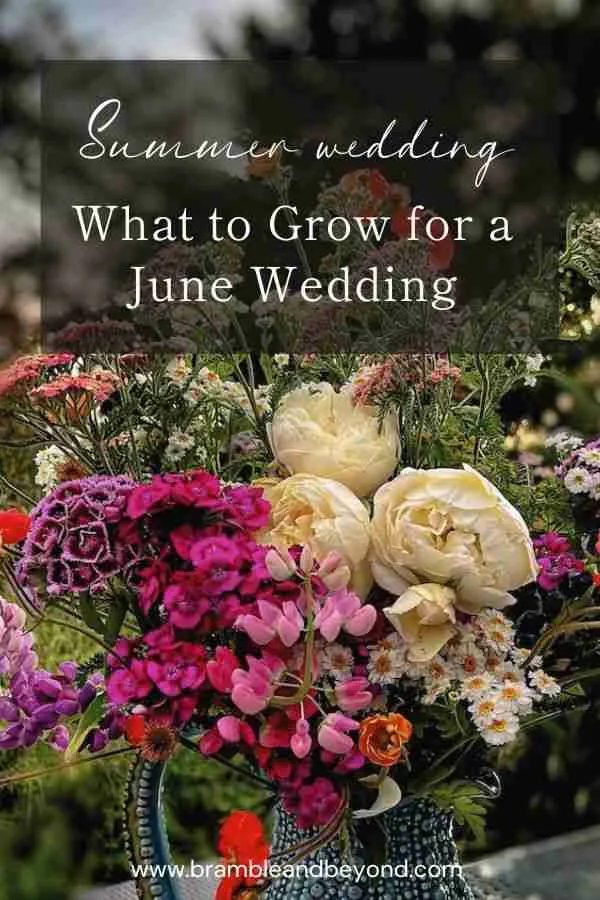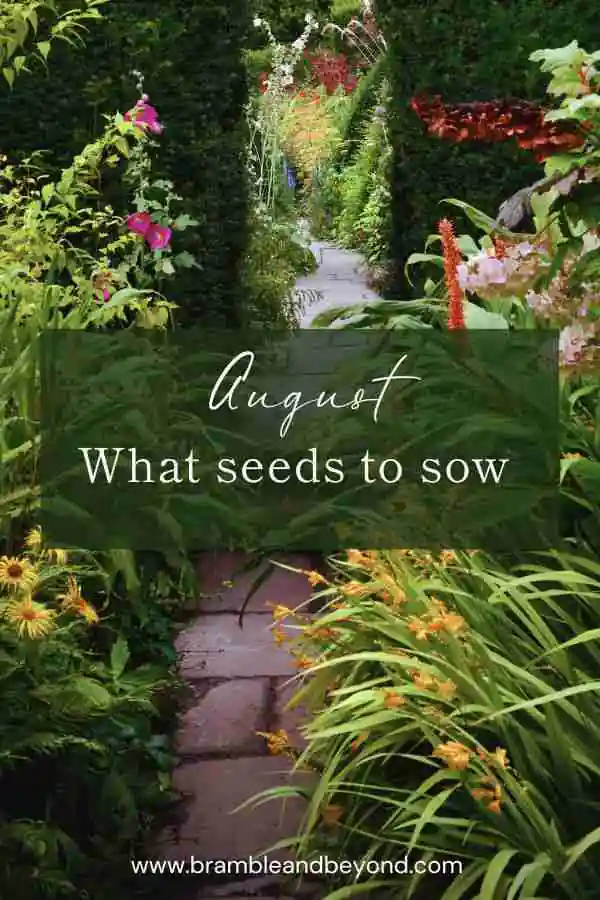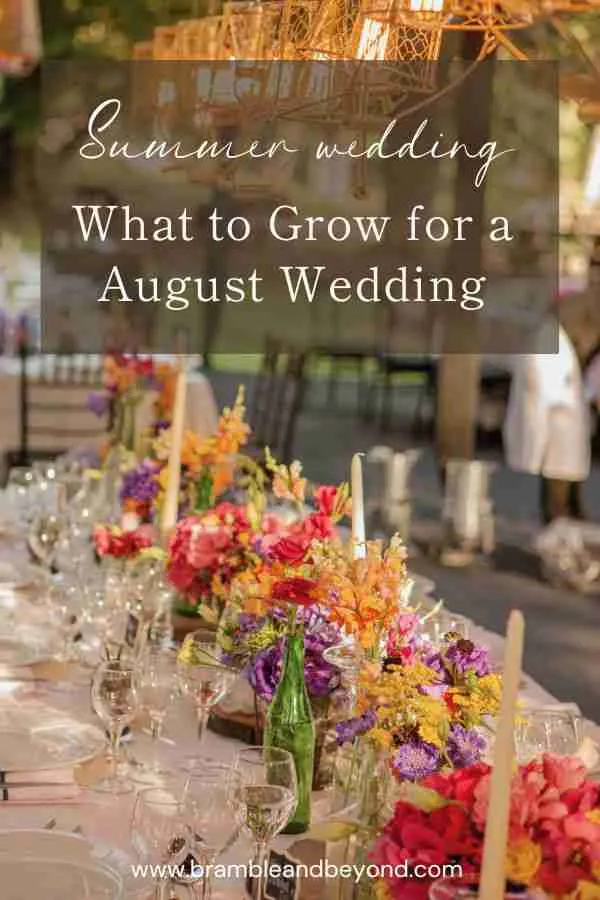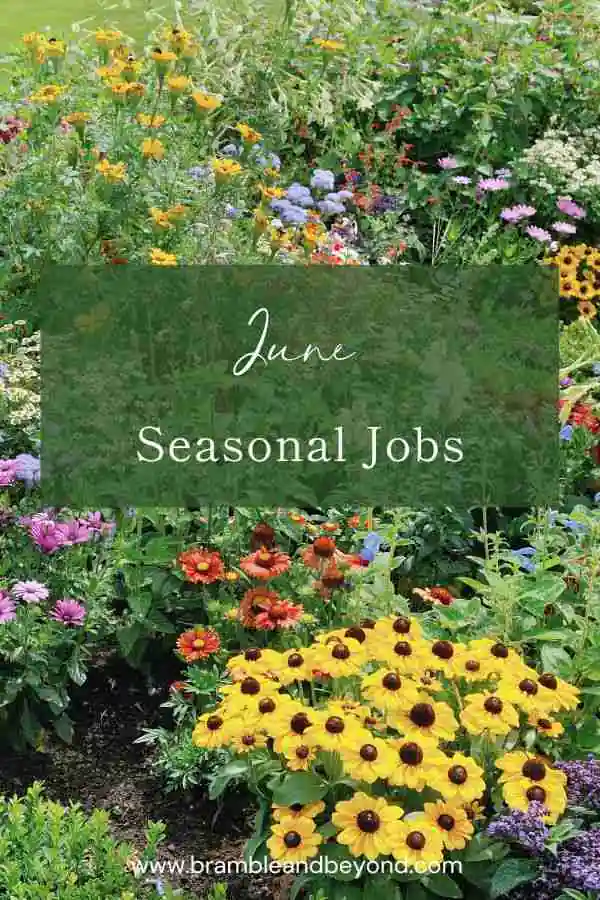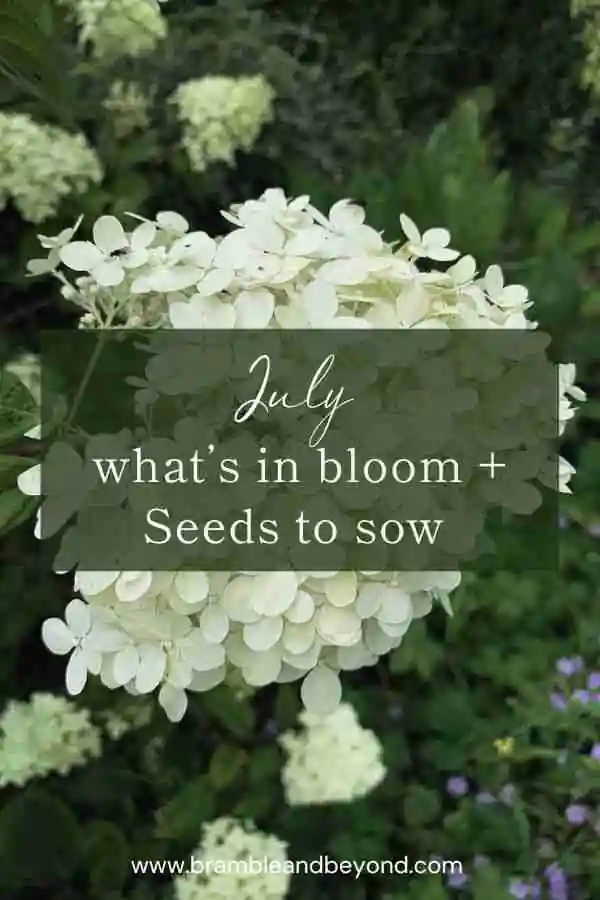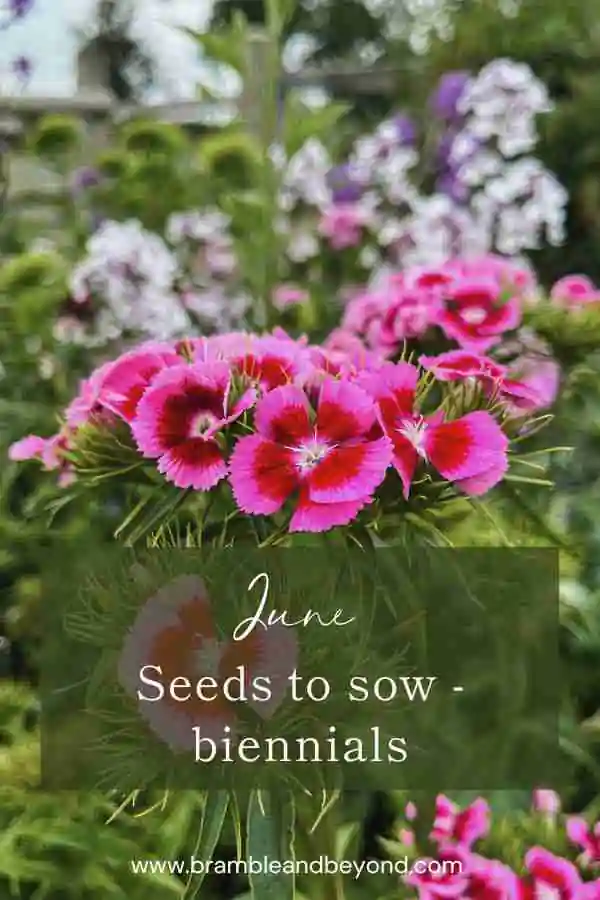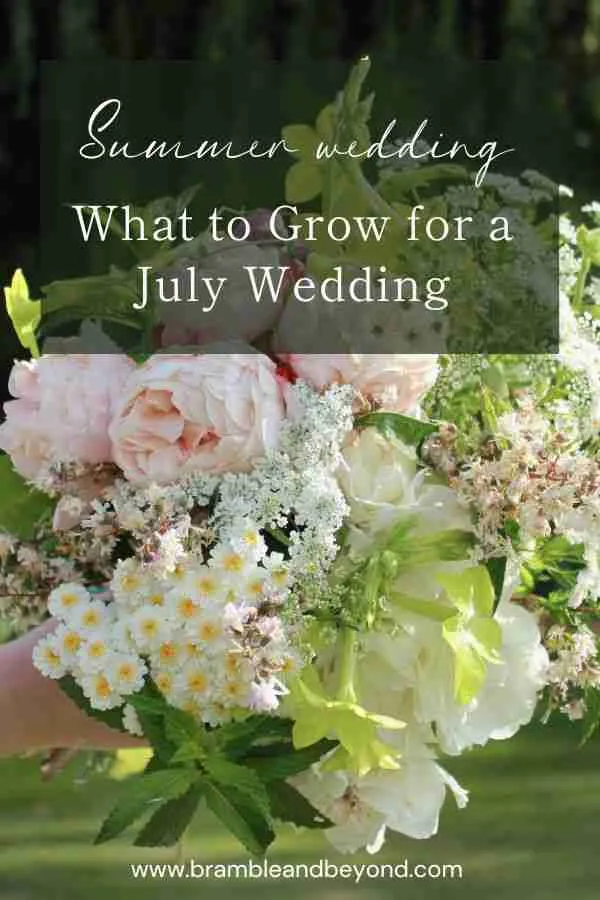Disclosure: This post may contain affiliate links, meaning I get commission if you decide to make a purchase through my links, at no cost to you. Please read my Affiliate Disclosure for more information.
Planning a wedding can be a whirlwind of stress and excitement, but one thing that can truly make your special day unforgettable is the presence of beautiful flowers. As you dive into the preparations for your June wedding, you might find yourself pondering which flowers would be the perfect fit for the occasion. Well, fret not! Let’s embark on a journey through sustainable seasonal flower gardening and discover the best flowers to grow for your June wedding.
Ah, June, a curious time in the flower growing season. The spring bulbs have just finished their magnificent display, and the spring-sown seeds are still finding their footing. It’s what we call the “June gap”! To ensure a continuous burst of floral beauty, we’ll need to embrace the wonders of biennials. These delightful plants were sown the previous year and are now ready to showcase their splendour.
Early summer wedding flower growing guidelines
To make growing your own flowers for your June wedding a breeze, let’s use the season of your wedding to guide you towards the perfect colours and plants. June flowers still retain some of the fresh, clear colours of spring but gradually transition into softer and more muted tones as we journey towards summer.
In this series of articles for each month of the growing season, I’m thrilled to share varieties that are not only simple for beginners to grow but are also guaranteed to bloom abundantly. Plus, they won’t take up too much space in your garden, allowing you to enjoy a bountiful harvest of blooms. Now, let’s dig into the exciting world of sustainable seasonal flower gardening and discover the fabulous flowers to grow for a June wedding!
First, let’s set a few ground rules and assumptions for this flower filled adventure:
- First things first, I’ll assume you don’t have an established garden at your disposal, otherwise you have more options to forage from your existing garden. Keep in mind that perennials and shrubs need time to establish and reach a decent size to produce enough flowers. Expecting a rose planted just a year before your wedding to provide enough blooms is like wishing for a magical garden overnight. However, if you already have three or four well-established rose bushes that have been around for at least three years, you might just be in business!
- Next, most of my suggestions will focus on flowers that can be sown and bloom within a single season. Note that this might mean sowing them a year in advance to have the widest selection and the most blooming options for your special day.
- Another important factor is space. You’ll need sufficient dedicated garden bed space to grow the flowers required for your wedding. To help you estimate how much space you’ll need for your dreamy floral arrangements, check out my handy guide on calculating the space needed for growing cut flowers.
- The quantities I provide in my floral recipes are based on creating one stunning pedestal arrangement. If you’re curious about the number of flowers needed for other wedding arrangements, I’ve got you covered with this helpful resource for calculating how many wedding flowers you need.
- If you’re feeling adventurous, I’ve even added a category called “Fancy” flowers. These are the blooms that add an extra touch of texture, magic, or wow factor to your arrangements. They’re completely optional, but if you’re looking to create arrangements that truly sparkle, these fancy flowers are for you.
- Finally, keep in mind that growing your own flowers means embracing a certain level of imperfection. If you’re envisioning perfectly straight roses, tulips, or ranunculus, it may be best to entrust your floral needs to a talented florist. Growing your own means embracing the natural beauty and charm of each bloom, even if they have a hint of insect nibbles. Trust me, the result will be a breathtaking display of beautiful and whimsical flowers that will make your heart flutter.
Remember, you can only cut what is in bloom at the time of your wedding. As much as we’d love to will peonies or roses into flowering on demand, Mother Nature has her own timeline. While you can provide optimal growing conditions for seeds and bulbs to encourage growth, it’s an advanced gardening technique that requires additional equipment. So keep this in mind as you embark on your journey into sustainable seasonal flower gardening for your June wedding.
Flowers to grow for a June wedding
To help you create the most beautiful arrangements for your June wedding, take a look at the following list of flowers that are in season this month. The table below highlights some of the flowers that bloom in June and are known for being easy to grow. The perennials, shrubs, and trees are included as suggestions in case you have the opportunity to obtain them from friends and neighbours.
As June is early in the growing season, if you are getting married early June, I would be inclined to protect all my hardy annuals from frost so that you can nurture them and ensure a better winter survival rate and earlier flowering. or focus on some biennials, as these are a lot more reliable. If you are getting married later in the season then it’s not so critical.
| Name | Type | Flower Form | Sow |
|---|---|---|---|
| Agrostemma (Corn cockle) | Annual | Filler | Aug-Sep year before |
| Ammi majus (Bishops flower) | Hardy Annual | Filler | Feb-Jun |
| Ammi visnaga (Queen Anes Lace) | Annual | Filler | Aug-Sep year before |
| Calendula (Marigolds) | Annual | Filler | Mar -May |
| Campanula (Canterbury Bells) | Biennial | Filler | Feb – June year before |
| Centaurea cyanus (Cornflower) | Annual | Filler | Aug – Sep year before |
| Clarkia (Godetia) | Annual | Filler | Mar – April |
| Cosmos | Annual | Filler | Mar – May |
| Cynoglossum amabile (Chinese Forget me not) | Hardy Annual | Filler | Sep – Oct year before |
| Erysimum cheiri (Wallflower) | Biennial | Filler | Aug-Sep year before |
| Gypsophila (Baby Breath) | Annual | Filler | Feb – April |
| Hesperis matronalis (Sweet Rocket) | Biennial | Filler | May – July |
| Lathyrus odoratus (Sweet Pea) | Hardy Annual | Filler/Fancy | Oct – May year before |
| Lisianthus (Eustoma) | Hardy Annual | Filler | April – June |
| Lunaria annua (Honesty) | Biennial | Filler | Apr – Oct year before |
| Malope | Annual | Filler | Feb – Apr |
| Nigella | Hardy Annual | Filler | Sep-Nov year before |
| Alliums | Bulb | Focal | Sep-Oct year before |
| Callistephus chinensis (China Aster) | Annual | Focal | Feb-Apr |
| Dianthus (Sweet William) | Biennial | Focal | Jan – Mar year before |
| Digitalis (Foxglove) | Biennial | Focal | May – June year before |
| Larkspur | Hardy Annual | Focal | Sep – Apr year before |
| Matthiola incana (Stock) | Annual | Focal | Feb – Mar |
| Ranuculus | Corm | Focal | Oct -Nov year before |
| Basil | Annual | Foliage | Apr – May |
| Cerinthe Major (Honeywort) | Hardy Annual | Foliage | Sep – Oct year before |
| Daucus | Hardy Annual | Foliage | Oct – Apr year before |
| Dill | Annual | Foliage | Mar – Jul |
| Lepidium sativum (Greek Cress) | Annual | Foliage | May – Oct |
| Salvia (Sage) | Annual | Foliage | Mar -May |
| Geum, Achillea (Yarrow), Aquilegia (Granny’s Bonnet, Columbine) | Perennial | Filler/Fancy | |
| Astrantia (Masterwort), Linaria (Toadflax), Lysimachia (loosestrife), Penstemon, Sanguisorba, Tanacetum parthenium (Feverfew), Mentha (Mint) | Perennial | Filler | |
| Lupin, Peony, Rose | Shrub | Focal | |
| Physacorpus (NineBark), Brachiglotis, Cornus, Philadelphus | Shrub/Tree | Foliage |
Instead of trying to grow everything, why not stick to just 6 or 7 varieties? This way you can grow more of the same flowers to create arrangements that have a consistent theme throughout.
Aim for 1/3 of focal flowers, 1/3 of filler flowers, and 1/3 of foliage. And if you want to add some extra flair, feel free to include any optional fancy decorations to make your arrangements sparkle!
June wedding flower arrangement recipe
For a June wedding with 100 guests, you may need to consider the following type of arrangements along with the average number of stems required.
When it comes to selecting the ideal flowers for your June wedding, the options may seem endless, but they don’t have to be if you stay focussed on your chosen style and colours. Use the above list as a guide for the flowers that are in their prime during June.
| Arrangement | No. of Stems | No. of Arrangements | Total Stems |
|---|---|---|---|
| Jam-jar posies | 20 | 10 | 200 |
| Large jugs of flowers | 50 | 3 | 150 |
| Pedestal arrangement | 75 | 1 | 75 |
| Bride’s bouquet | 50 | 1 | 50 |
| Bridesmaids’ posies | 35 | 3 | 105 |
| Buttonholes | 5 | 5 | 25 |
Using a pedestal arrangement as an example, one recipe for an early June wedding could be:
- Focal – 10 ranunculus, 8 alliums, 7 foxglove,
- Filler – 5 nigella, 10 sweet rocket, 10 orlaya/ ammi majus,
- Foliage – 5 tall branches of foliage, 10 dill/sage, 10 cerinthe major,
- Fancy – sweet pea tendrils (or the flowers, if they happen to be in bloom), or aquilegia.
You could also look at the arrangement recipe suggestion for May as some of the flowers may still be possible for early June.
A recipe for a late June wedding could be as follows:
- Focal – 5 china aster, 10 alliums, 10 larkspur/foxglove,
- Filler – 5 malope, 10 cornflower, 10 ammi majus,
- Foliage – 5 tall branches of foliage, 10 daucus/mint/sage, 10 cerinthe major.
- Fancy – sweet pea tendrils, nigella seed heads, corn flower.
You could also look at the flower arrangement recipe suggestion for July as some of the flowers may be possible for a late June.
These recipes will create an arrangements of blues, purples, white and green.
Alliums
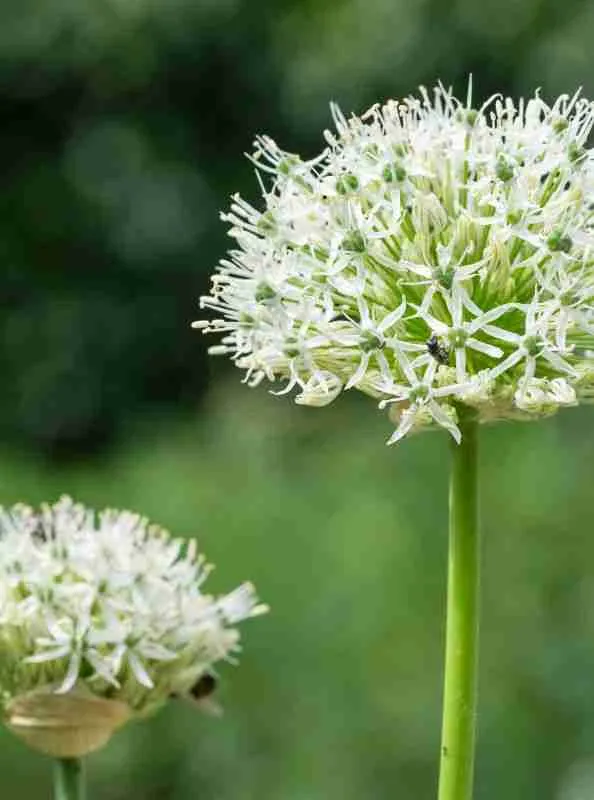
Alliums are one of my favourite flowers because they are so unique and visually stunning when planted together in a garden. They can add a beautiful touch of colour to any bouquet for a June wedding.
They come in a variety of colours, ranging from vibrant purple to delicate white, and even some with hints of pink and green. The flower heads resemble sparklers, with different sizes and a playful appearance.
Alliums are single-cut flower stems, so be sure to plant enough of them. The good news is, they can be replanted after the event, so you can enjoy them for years to come.
To have Alliums ready for use, they are typically planted in early Autumn, a year in advance.
Ranunculus
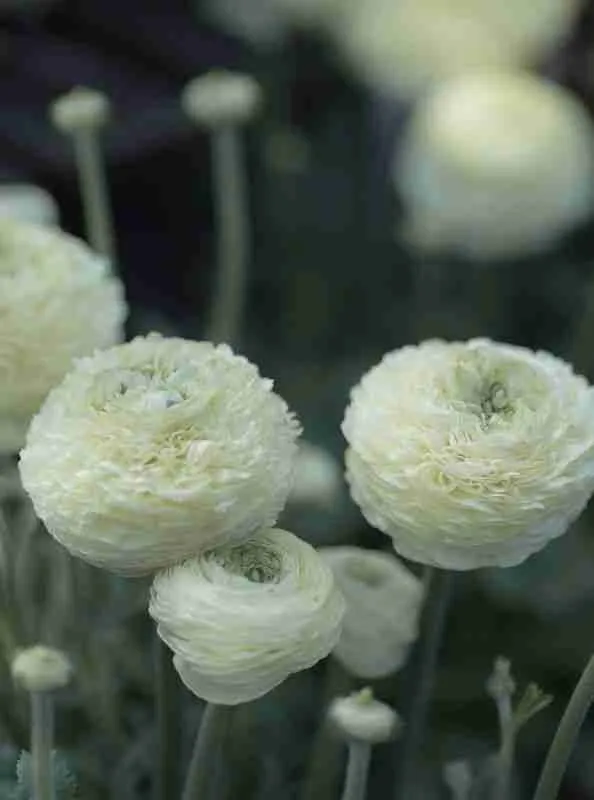
Ranunculus flowers are quite popular for weddings in May and June, although they can be a bit challenging to grow. They require a bit more attention compared to Tulips and Alliums. Ranunculus are corms and prefer warm conditions to start growing. After that, they need to be kept adequately moist, but not overly so. They also prefer a cool environment, but not excessively cold. In case of frost, it may be necessary to provide some protection for them, which can result in earlier blooming.
These flowers come in various colours and have delicate petals that create a beautiful and soft appearance. They kind of resemble roses so may work as rose replacements.
Additionally, Ranunculus flowers have a unique shape that can be used to add texture and depth to any flower arrangement.
Corms are similar to bulbs, which means theoretically they can be replanted and bloom year after year.
Ranunculus flowers have multiple stems, and it is possible to get around 5 stems per corm. Regularly picking the flowers can encourage more blooms.
Foxglove
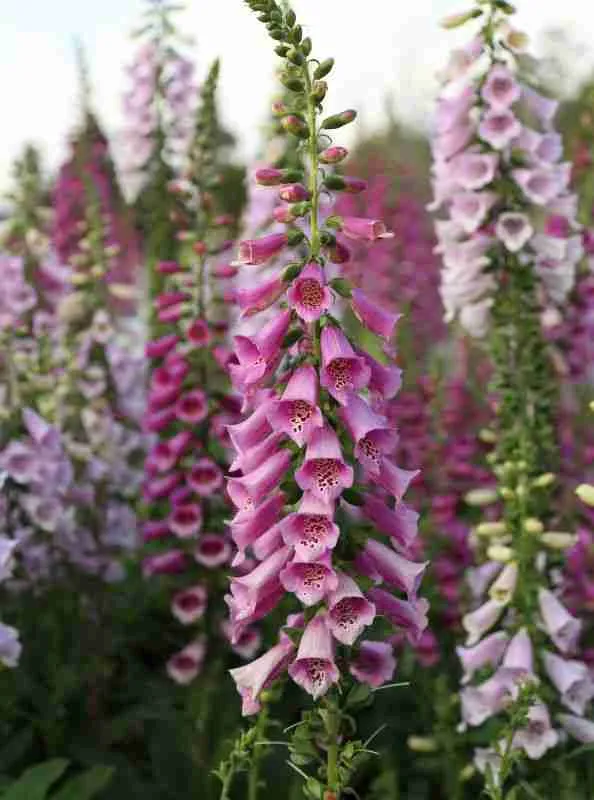
Foxgloves can easily create a wow factor in any arrangement. With its tall stems and beautiful bell-shaped flowers in various shades, it’ll add a touch of elegance to your special day. I grew sutton’s apricot last year and it was an absolutely gorgeous peachy colour.
Now, here’s a little tip about Foxglove: it’s a biennial, which means you’ll need to sow it the previous year.
Foxglove is generally a single-stem flower, so make sure you have enough plants to cover each stem you want. However, I have found in recent years that once the central flower head is cut it produced easier to use smaller side-shoots.
China Aster
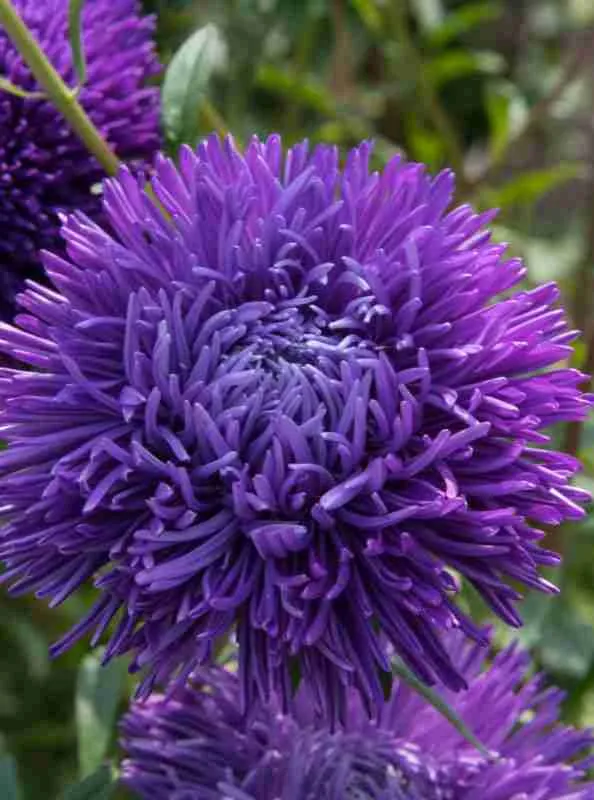
China aster is a delightful tender annual flower that is perfect for late June weddings. With its large and round shaped flower heads on upright stems and beautiful incurved petals in shades of purple, pink, white, and yellow, they can easily be mistaken for Chrysanthemums.
This lovely flower has a great texture and can be used as a focal flower in bouquets and arrangements. The best part is that china aster is easy to grow from seed, so you can sow them in the early spring and enjoy their beautiful blooms in June. They are tender annuals, but do take quite a long time to get started so make sure you sow them from February to give yourself a chance of lowers in June.
What’s more, China aster is a multi-stem flower, which means you can have about 3 stems per plant at any one time.
Larkspur
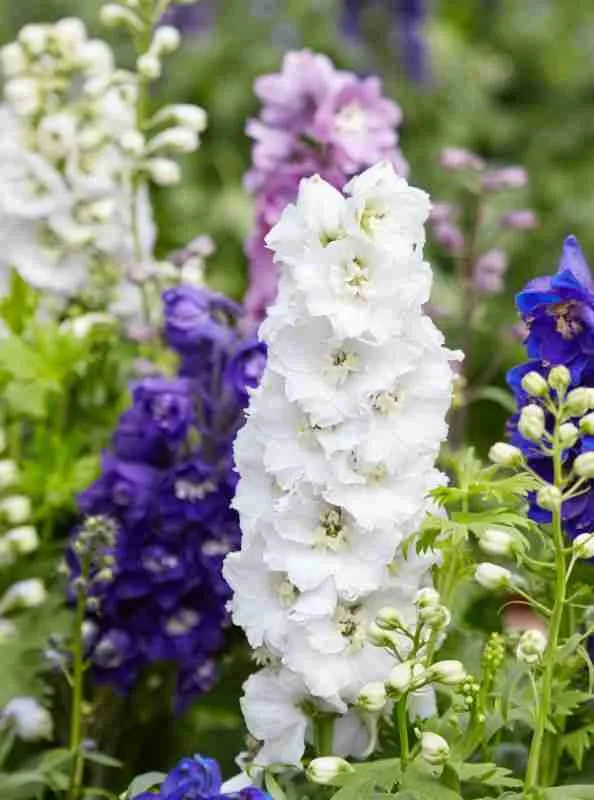
Larkspur is a beautiful and hardy annual flower that is often chosen for June weddings. Its tall stems are adorned with stunning flowers in shades of deep blue, pink, or white.
I must admit that germinating Larkspur can be a bit challenging. However, once they have successfully germinated, they are quite easy to care for and grow. For the best results, it is recommended to sow the seeds in early Autumn to enjoy the flowers in June.
To encourage more blooms, you can trim back the spent blooms. Keep in mind that Larkspur is considered a single-stem flower at any given time, so make sure you have enough stems to create a beautiful arrangement.
Nigella
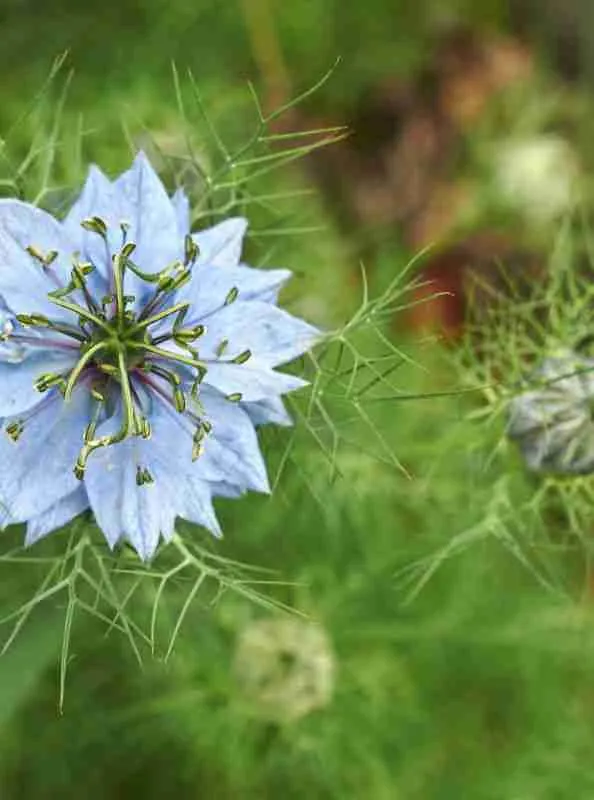
Nigella, also known as ‘Love-in-a-mist’, is a truly beautiful hardy annual flower that would be absolutely perfect for a June wedding.
It boasts delicate, fern-like foliage that is adorned with small, exquisite, star-shaped flowers in a delightful array of blue, white, pink, and purple shades. These charming flowers would make a wonderful addition to any bouquet, and the unique texture of the seed heads can be used to create stunning arrangements.
Growing Nigella from seed is a breeze, and it is best to sow the seeds in the autumn or early spring to enjoy its magnificent blooms in June. This flower produces multiple stems, so you can expect around 3 stems per plant at any given time.
Malope
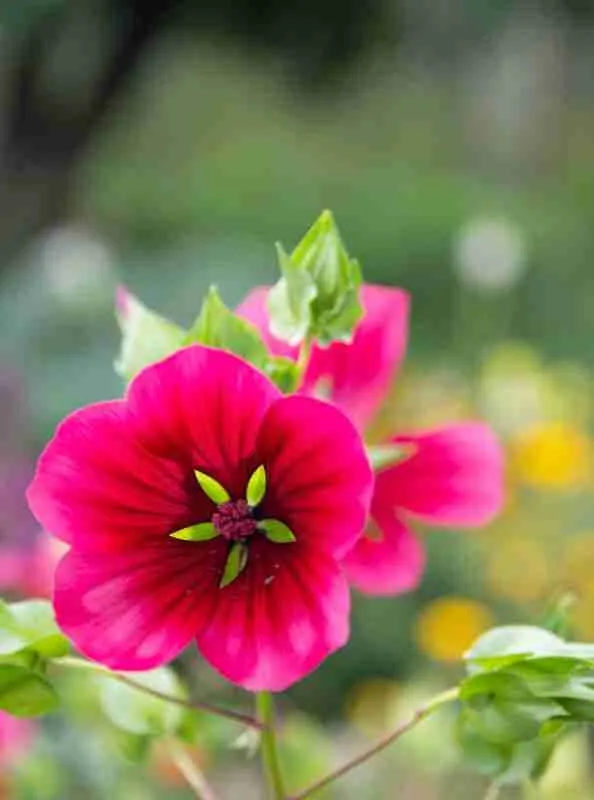
Malope is a lovely tender annual flower that is absolutely perfect for a beautiful June wedding. It features clusters of large, exquisite flowers in delightful shades of white or pink, adding a unique and vibrant pop of colour to any bouquet.
What’s great about Malope is that it’s incredibly easy to grow from seed, resulting in large and stunning plants. For the best results, it’s recommended to sow the seeds in early spring, ensuring a splendid display of flowers in June.
The best part is that Malope is a multi-stem flower, meaning you can expect up to 5 stems per plant at any given time, creating an even more breathtaking arrangement.
Cornflower
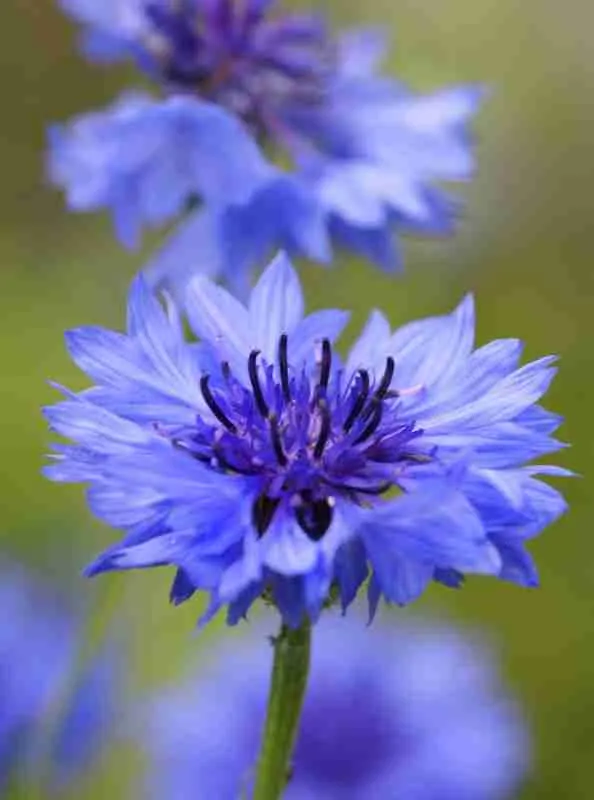
Cornflower is a wonderful choice for a June wedding. It features a small head with delicate petals. Personally, I adore the Black Ball variety, which showcases a stunning deep blue/purple hue. The best part is that it complements any colour scheme, adding depth and shade to the arrangement.
This charming flower is available in shades of blue, purple, and white, and it can truly make any bouquet stand out with a unique pop of colour.
The great news is that Cornflower is quite easy to grow from seed. Simply sow the seeds in early spring, and you’ll have beautiful flowers blooming in June. It’s a multi-stem flower, so you can expect to have around 7 stems per plant at any given time.
Sweet Rocket
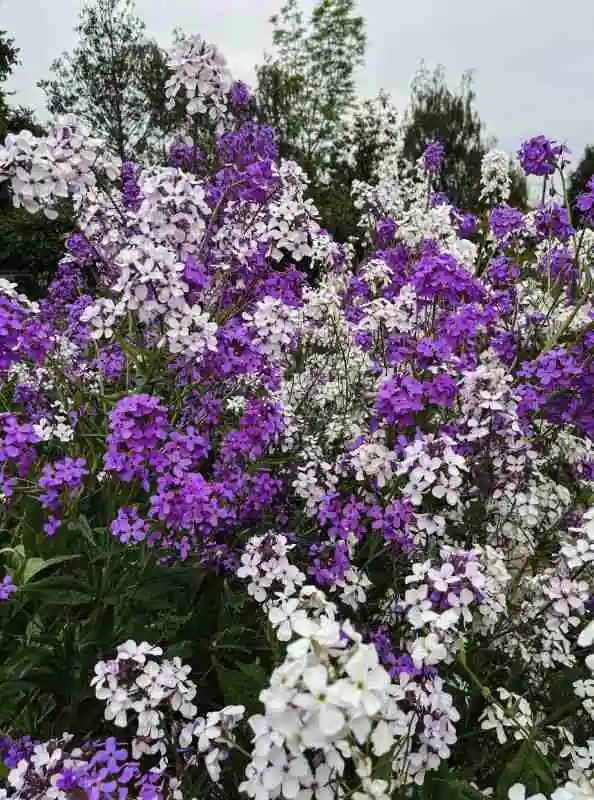
Sweet Rocket is a delightful flower that is ideal for early June weddings. It boasts delicate petals and a distinctive shape that can enhance the texture and dimension of any arrangement.
Typically, Sweet Rocket is available in either white or soft purple hues.
Once again, it’s important to note that these flowers are biennials, meaning they should be sown the year before. However, this time it should be done in early summer so that the plants are large enough to bloom in the following May/June.
Sweet Rocket is a multi-stemmed plant, and you can expect to have around 6-10 stems per plant at any given time.
Orlaya
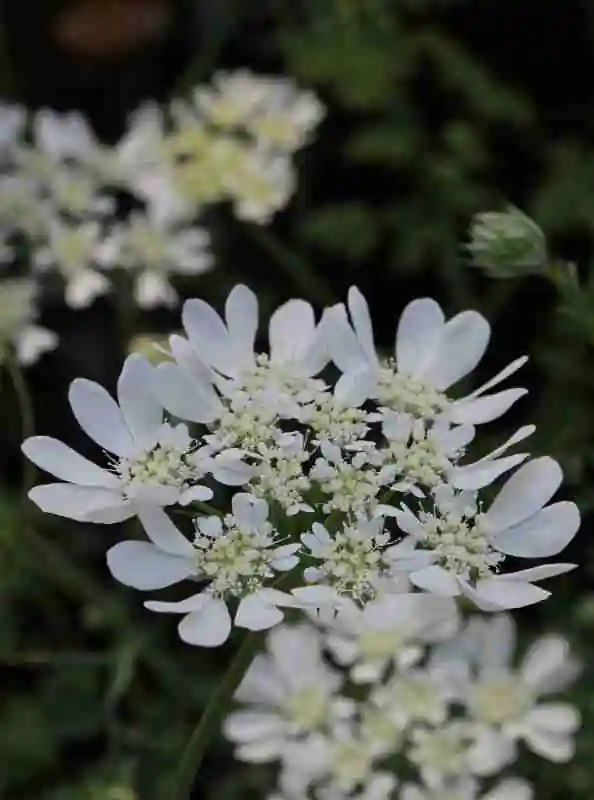
Orlaya is an absolutely stunning and unique hardy annual. It has beautiful, fern-like foliage and incredibly lovely, lace-like, pure white umbels. If you’re a fan of the ethereal white lace look of roadsides covered in Cow parsley, this plant will definitely give you that same effect.
This resilient annual should be planted in the previous autumn so that it blooms in May/June. If you grow enough of it, you can even use it as foliage.
Orlaya is a plant with multiple stems, and you can expect to have around 6 flowering stems per plant at any given time.
Ammi Majus

Ammi majus is a wonderful choice for a June wedding. It features delicate foliage and beautiful white flower heads that resemble cow parsley.
Growing Ammi majus from seed is quite simple, and it’s best to sow the seeds in autumn or early Spring for blooms in June. This plant produces multiple stems, with around 6 stems per plant at a time. This plant is easier to grow than Orlaya, in my opinion.
I personally enjoy the continuous blooming of this plant throughout the summer, making it a must-have in my cutting garden.
Cerinthe Major
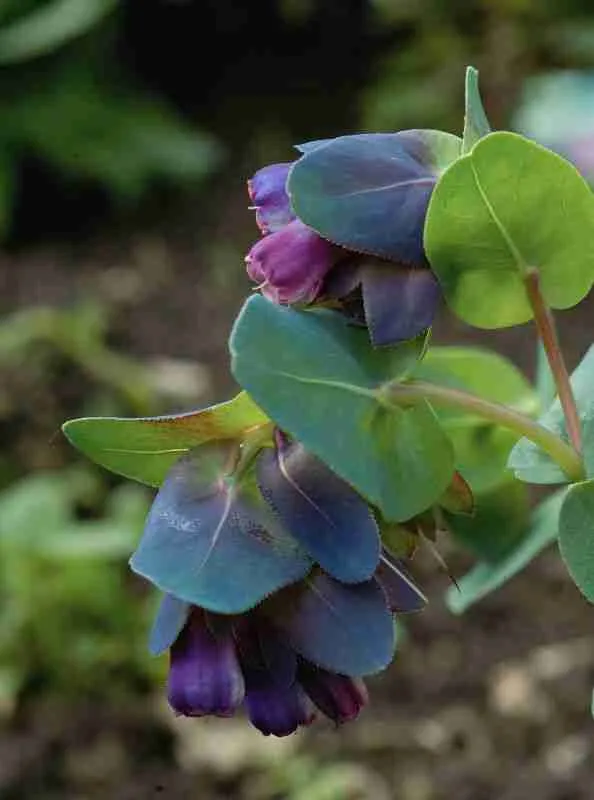
Cerinthe Major is a beautiful annual flower that would be perfect for a June wedding. I’ve classified it as foliage because of its unique blue-green leaves that gradually turn purple as they grow.
And let’s not forget about the flowers – they are unlike anything else you’ll see, with tubular shapes and a dark purple-blue colour. Despite being small and discreet, they add a touch of elegance without overpowering other elements in your arrangement.
Cerinthe Major is a great choice for adding texture and depth to your floral design. It is a resilient plant that can be easily grown from seed, and for best results, it should be sown in the previous autumn to bloom in June.
Dill
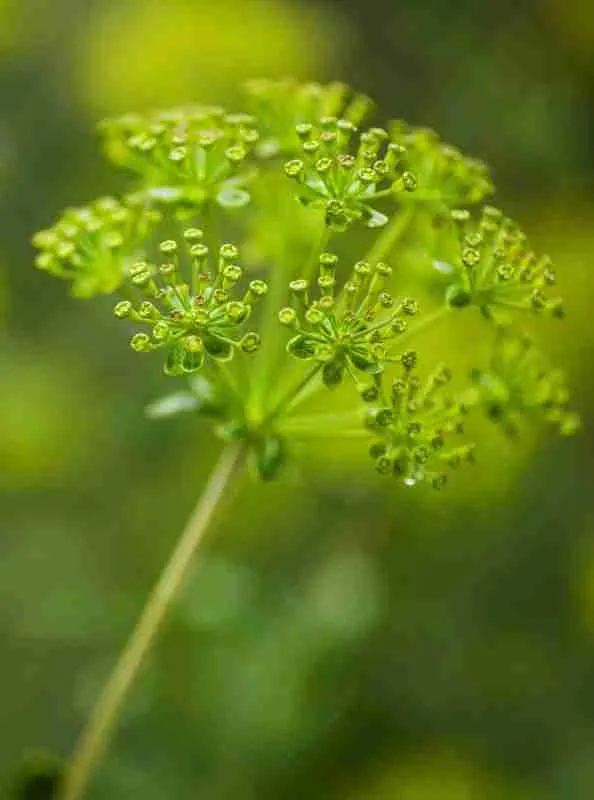
Dill is a wonderfully easy herb to grow. By adding a touch of dill to your arrangement, you can bring a whole new dimension to it. With its delicate, feathery leaves and small yellow/green flowers, dill creates a soft and airy feel when incorporated into floral arrangements.
Growing dill from seed is a breeze, and it’s best to sow them in early spring for beautiful flowers in June.
This plant has multiple stems, allowing you to have around 6 stems per plant at any given time. This is especially useful if you’re mainly using the foliage rather than the flower heads.
Daucus Carota
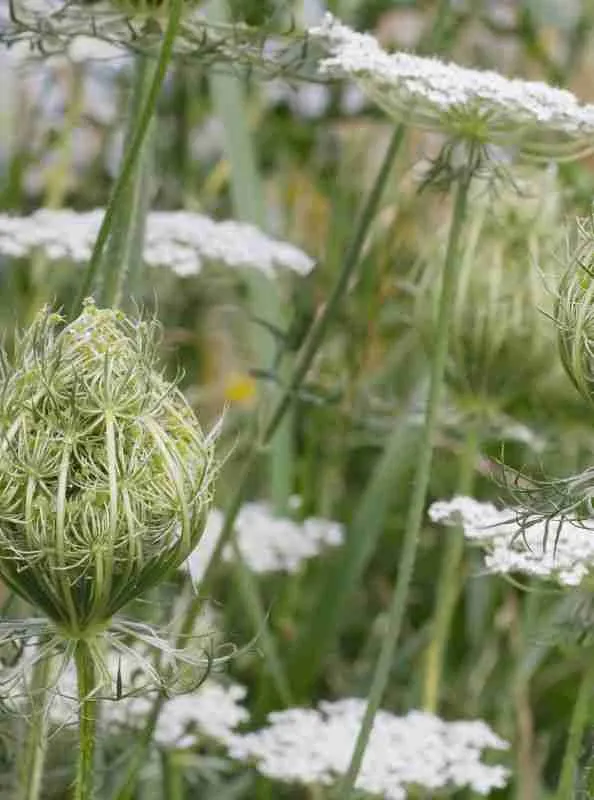
Daucus Carota, or Queen Anne’s Lace, is a lovely hardy annual/biennial flower that is perfect for June weddings. It features delicate, feathery foliage and beautiful green or faded pink flowers. Daucus is an excellent choice for adding texture and depth to floral arrangements, serving as a filler or foliage flower.
Daucus Carota is easy to grow from seed and thrives when sown directly in the autumn, resulting in beautiful flowers in June.
This flower produces multiple stems, allowing you to enjoy approximately 5 stems per plant at any given time.
Sweet Peas
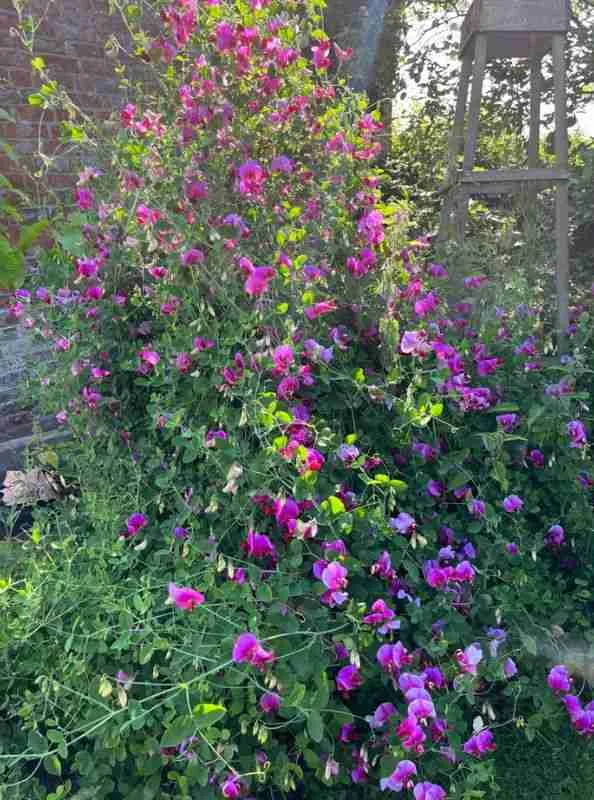
Sweet Peas are a wonderful addition to any floral arrangement, and they can be used to bring a unique texture and a pop of colour. Even the Sweet Pea tendrils are perfect for adding a distinctive, wispy touch to your bouquet and arrangements.
However, it’s worth noting that they don’t last long once they’re cut. So, while they are beautiful and abundant bloomers, it’s a good idea to ensure that you already have focal and filler flowers accounted for.
Nevertheless, they can easily be transformed into lovely small jam-jar arrangements, so there’s no need to completely avoid using them.
Sweet Peas are simple to grow from seed and should be planted in the autumn for blooms in June.
These flowers are cut-and-come-again, meaning that you can get around 5 stems per plant at any given time.
These flower examples are here to give you an idea for your mid summer wedding, but there are plenty of options to choose from. Sarah Raven is a great place to start looking for ideas. I love her site, it’s like flower inspiration overload! However, sometimes the quality of the seeds, tubers, and bulbs can be a bit hit-and-miss, and they can also be a bit pricey. On the other hand, I have been really impressed with the quality of the bulbs and tubers from Peter Nyssen, and if you’re looking to buy seeds I have seeds for all of the annuals and biennials mentioned above in my shop, but Chiltern Seeds is also a fantastic place to go.
The wonderful thing about a June wedding is that you can start growing hardy annuals the year before, so you can get a head start and create something truly special once spring arrives.

